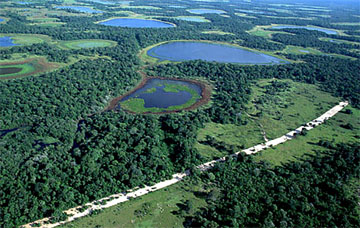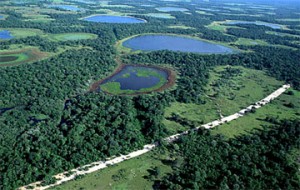CORUMBA, Brazil, (Reuters) – Jaguars still roam the world’s largest wetland and endangered Hyacinth Macaws nest in its trees but advancing farms and industries are destroying Brazil’s Pantanal region at an alarming rate.
The degradation of the landlocked river delta on the upper Paraguay river which straddles Brazil’s borders with Bolivia and Paraguay is a reminder of how economic progress can cause large-scale environmental damage.
“It’s a type of Noah’s Ark but it risks running aground,” biologist and tourist guide Elder Brandao de Oliveira says of the Pantanal.
Brazil’s exports of beef, iron and to a lesser extent soy — the main products from the Pantanal — have rocketed in recent years, driven largely by global demand.
Less well-known than the Amazon rain forest, the Pantanal is larger than England and harbors a huge fresh water reserve and extraordinary wildlife, ranging from 220-pound (100-kg) jaguars to giant otters that mingle in water holes packed with nine-foot (3-metre) caimans. the world’s largest freshwater wetland, it is almost 10 times the size of Florida’s Everglades.
Of the Pantanal’s 650 bird species, the largest has a wing span of nearly 3 metres (yards) and the smallest weighs only 2 grams (0.07 ounce).
During the rainy season the water level rises by as much as five metres (yards), creating a mosaic of dark-brown swamps with islands of shrubs and tall standing tropical trees. When the water first hits dry soil it loses oxygen and kills schools of fish as part of a nose-wrenching natural life cycle.
A melting pot for various ecosystems, the Pantanal has the greatest concentration of fauna in the Americas, according to The Nature Conservancy, a global environmental advocacy group.
But some species are in danger of disappearing, including the long-snouted giant anteater, which claws into anthills and flicks its two-foot tongue up to 160 times per minute to quickly gobble up stinging ants.
The giant armadillo and maned wolf are also on the list of endangered species because of their falling numbers.
Visitors to the Pantanal marvel at the idyllic scenery and the proximity and abundance of wildlife.
“I hadn’t heard about it before, it’s a bird-lovers’ paradise,” said Alkis Ieromonachou, a Cypriot tourist, eyeing a group of giant Jabiru storks from the deck of a bungalow. The impact of modern farming is obvious even in the tourist resort, however, as a large herd of cattle wanders through the swamp, squashing floating lily pads.
Cattle ranchers cut trees on higher elevations and sow pasture in the lowlands, which are flooded for months. Many say they have been here for decades and can’t be expected to abandon the land and their livelihood.
“True, deforestation is a problem but 50 years ago when it began nobody thought of these things,” said Ademar Silva, head of the local association of farmers and cattle ranchers. “The government needs not only to punish bad behavior but promote new technology with financial incentives.”
ECONOMIC
PRESSURES
Brazil’s beef exports have more than tripled in five years to $5 billion in 2008, with pasture often replacing forests. Experts say improving productivity, from currently around one head of cattle per hectare (2.5 acres), could prevent much deforestation.
“We’re using our natural resources fast and inefficiently,” said environmental economist Andre Carvalho at the Getulio Vargas Foundation, or FGV.
The environmental group Conservation International says 63 percent of the forest in elevated regions of the Pantanal and 17 percent in lowland regions have been destroyed.
Under a federal law dating back to 1965, ranchers can clear up to 80 percent of the forest on their property. Parks and protected areas make up only a small fraction of the Pantanal, and the rest is largely unprotected.
Demand for charcoal from Brazilian pig iron smelters has accelerated deforestation, environmentalists say.
“We set up shop precisely to use wood from the advancing agricultural frontier,” said Vitor Feitosa, operations director for MMX, a smelter located in the Pantanal town Corumba and owned by Brazilian billionaire Ike Batista.
Brazil’s pig iron exports have grown sixfold to $3.14 billion since 2003. Around 1.5 million hectares (3.7 million acres) of native forest are lost annually in Mato Grosso do Sul state, home to much of the Pantanal, an FGV study showed.
Marcos Brito, head of a charcoal manufacturers group with 15,000 employees in the state, claims most producers use wood cut and discarded by ranchers. But Alessandro Menezes, an activist with the environmental group ECOA, says they clear forests in exchange for the wood. After being fined several times, MMX agreed not to buy Pantanal charcoal, but most smelters in the state still do.
Erosion resulting from deforestation has created large sandbanks on tributaries to the Paraguay river, such as the Taquari and Rio Negro, making them partially unnavigable.
“Rivers will change course, lakes appear or disappear — the size and shape of the Pantanal will change,” said Sandro Menezes, manager of Conservation International’s Pantanal project. “It’s very probable that local flora and fauna will become extinct.”
Already, there are signs that runoff water from nearby farms is altering the ecosystem’s delicate balance.
“We see trees flower and birds breed earlier — we believe it’s because of fertilizers in the water,” said de Oliveira.
The global financial crisis has hit demand for steel and beef and temporarily eased pressure on the Pantanal as smelters and farmers put expansion plans on halt. But most environmentalists agree the next commodity boom could cause irreversible damage.
“Now is the time for stricter laws, environmental education and corporate citizenship,” said Ricardo Melo, environmental public prosecutor in Corumba. “Economic development here is inevitable; we need to make it sustainable.”







